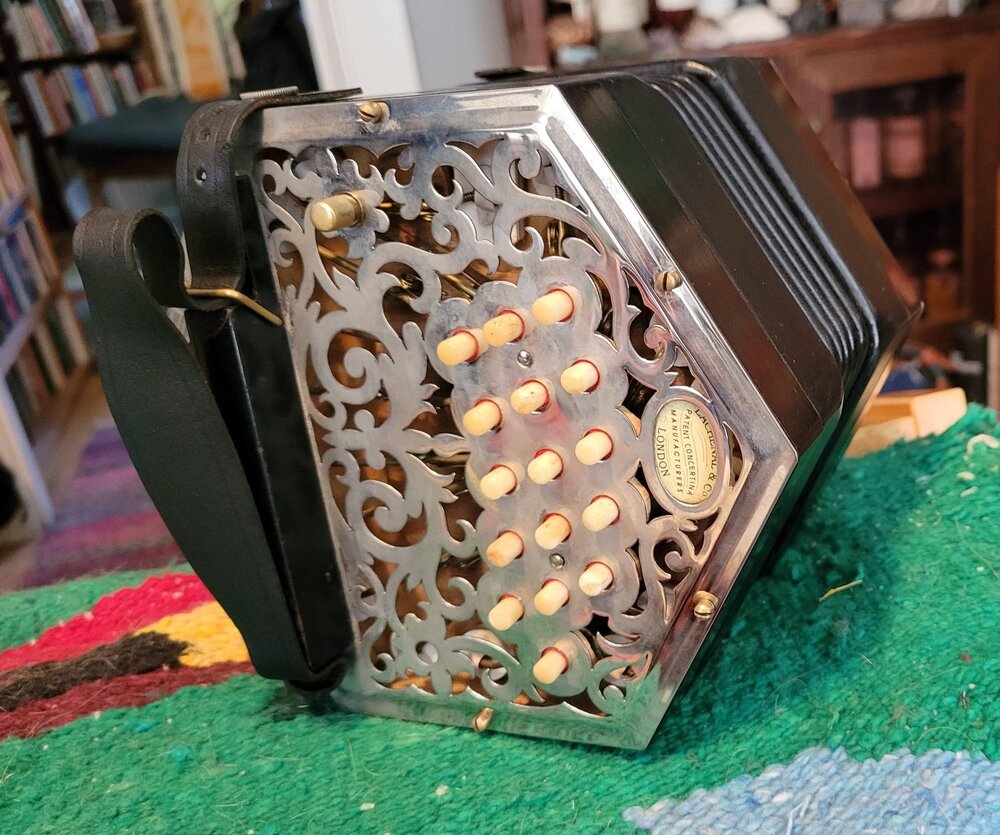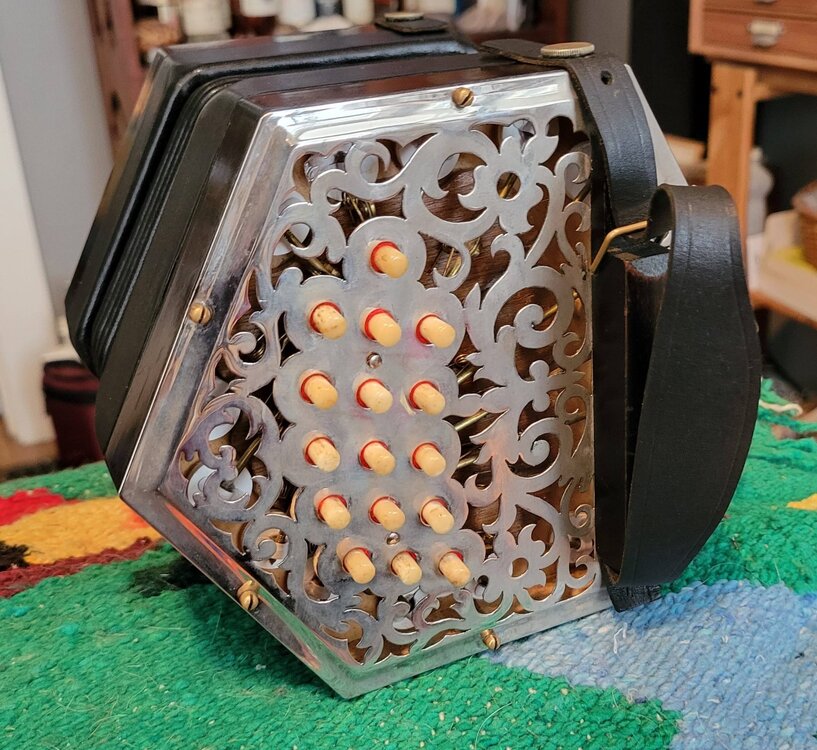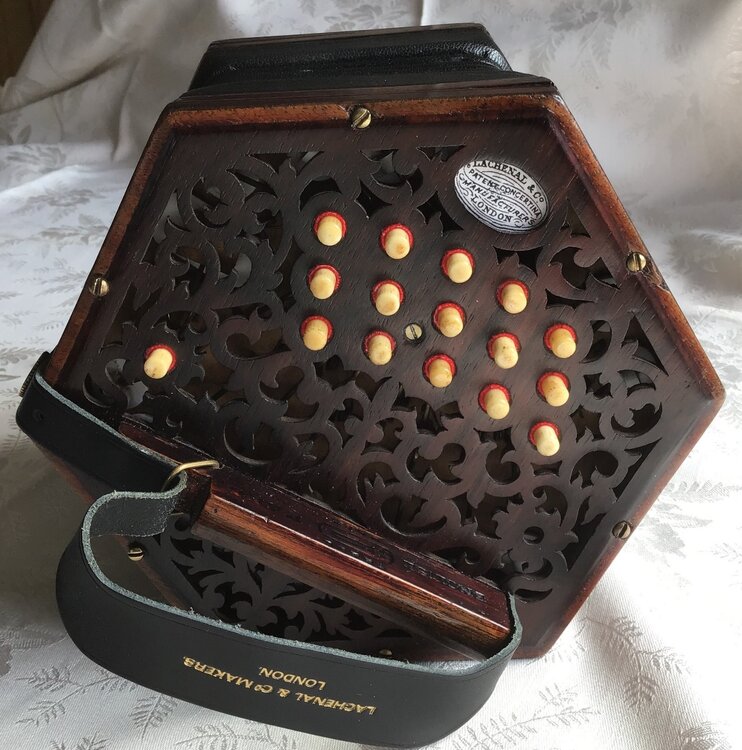-
Posts
12 -
Joined
-
Last visited
Profile Information
-
Location
Portland, Oregon, USA
Recent Profile Visitors
The recent visitors block is disabled and is not being shown to other users.
Sarah Cardin's Achievements

Member (2/6)
-

Buzzing reed on Carroll anglo, Part 2
Sarah Cardin replied to Sarah Cardin's topic in Instrument Construction & Repair
The short story: I still have the problem. I've stuck the reed pan up on my improvised light table and I haven't been able to see any point(s) of contact between the reed and the shoe. I've even looked at some of the other reeds in that part of the pan to see what they look like on the light table and I'm not seeing any difference between those reeds and the D reed on #22. If there's contact, it's not happening while I"m looking for light around the reed. Aside from looking for contact, I've also slide a piece of that very thin foil around the sides of the reed. It moves freely, which seems to be to be another sign that there's no contact. Are there any more ideas out there? -
Sarah Cardin started following Buzzing reed on Carroll anglo, Part 2
-
Back in July, I posted about a problem I was having with one of the reeds (?) on my Carroll anglo #150. It involved the pull D on button #22 (C row, right hand), which had a metallic buzz/sizzle as the button was released. It has a metallic sound, like something was vibrating that shouldn't be doing that. I tried a bunch of things on my own and got a lot of great suggestions from the last time I posted here. As you have certainly guessed, nothing worked. (The up side of all the troubleshooting I've been doing is that pretty much the only concertina repair tasks I haven't taken on since buying the Carroll are tuning reeds and any sort of bellows work. I am definitely no longer afraid to open the box up.) Here's what I've tried so far. I checked out the felt bushings on the button and buttonhole to make sure that the button was moving freely. This included opening up the action box to look directly at the assemblies inside. I pulled the reed shoe and plinked the reed. It sounded as though the reed was moving freely, but I put it on a makeshift light table to be sure. No apparent contact between reed and shoe. Using very thin metal foil, I cleaned the reed off to make sure there was no gunk or debris on it. Also, I put the reed back onto the light table to make sure there was still clearance on all sides. Under a magnifier, it looked like there might be junk adhering to the inside of the shoe near the reed screws, so I used the foil to carefully clear that stuff out. I checked the reed slot for anything on the sides or bottom that might be pressuring the reed shoe. I backed the reed shoe on button #22 out a bit. I shimmed the reed shoe on the side, and un-shimmed it, too. I swapped the D reed from button #15 on the left side G row with the 'problem' D reed on button #22. The 'problem' assembly worked just fine after moving it to the #15 push slot. No nasty noises at all, but former #15 reed assembly made that bad sound when moved into the #22 pull slot. I replaced the spring on button #22. I checked to make sure that none of the springs on #22 or any nearby buttons were contacting a lever arm. I replaced both valves on button #22. Most of these things had no effect on the sound. Backing the reed out made a minor imporovment. I think I've listed everything I've tried, but there were so many things that I might have forgotten something. I should mention that I've had several local players try the haunted button #22, and they all heard the problem sound. I"ve attached a new sound file if you want to hear it, too. It has me playing the D on #15 three times, and then playing the problem D on #22 three tiimes. So several months later, I still have the bad sound on button #22 that I started out with in July. I am *so* out of ideas at this point. Can anyone out there think of something I haven't tried? Sarah Carroll Left x 3, Right x 3.mp3
-

Dating A Lachenal From The Serial Number
Sarah Cardin replied to johnconstable's topic in Concertina History
I need a date for a 31-button anglo #142578. The number is stamped on the left reed pan. It was converted to riveted action by Colin Dipper and has a bellows by Rosalie Dipper. My guess is around 1895. Am I close? -

Buzzing reed on Carroll anglo
Sarah Cardin replied to Sarah Cardin's topic in Instrument Construction & Repair
I'm back with my final report. The short of it is that the problem is solved to the degree that playing the D note on #22 isn't making me nuts any more. I can still hear the problem if I listen hard for it, but no one else will notice. And, as Dave Elliott pointed out, it could just be due to the harmonics of this particular concertina. I'm not surprised that nobody noticed anything with the sound file -- my phone's mike did a bad job of catching the buzz/sizzle. In getting to this point, I did do what Wally Carroll suggested and played the note with my palms off the concertina. It didn't change the sound of the 'problem' reed at all. Both the buzz/sizzle and the hollowness were still there no matter where my hands were or how the instrument was oriented. I also messed around more with the position of the reed in the slot as suggested by Alex Holden. There turned out to be a sweet spot in terms of how far to back the reed off from the end of the slot. When I found it, the bulk of the bad sound I was hearing disappeared. And since I still suspected that there was a sympathetic vibration going on -- part of the harmonics -- I stuck a bit of museum putty on the lever arm just to see what happened. It wasn't a total solution, but it did make the note sound a bit better. My concertina definitely has its own little mystery spot ... So I'm happily playing away on this lovely instrument, finally. I'm crossing my fingers that the change in climate from its previous home and Portland's current hot, dry spell doesn't cause any more havoc with the concertina than it already has. Although dealing with this problems (and several far less intractable reed problems) has resulted in my no longer being afraid to open up a concertina, and I feel confident that I can diagnose and fix the common ailments. Thanks to Dave Elliott for his great instructions on making a new button bushing, and to Wally Carroll for all those great videos. Again, I really appreciate all the help I got here. Concertina.net is the best. -

Buzzing reed on Carroll anglo
Sarah Cardin replied to Sarah Cardin's topic in Instrument Construction & Repair
Thanks Alex for your advice. After I swapped the two reeds back to their original positions -- each one fit best in the slot where it started -- I backed the reed in the #22 pull slot off a bit from the end of the slot. It reduced the buzz/sizzle a bit, but did nothing much to fix the echo/hollowness of the sound the reed produced. No other reed on the instrument is making this kind of sound. Just whichever reed is occupying the #22 pull position. The concertina is more playable now, but the weird sound the reed is making still grates on me. I attached a sound file to this reply. Hopefully it caught the hollow sound I'm talking about. I really appreciate how people are going out of their way to help me with this. Weird Reed 2.mp3 -
Sarah Cardin changed their profile photo
-
I just got a Carroll 30-button Anglo from its previous owner and it's a lovely thing. Except for the pull D on button #22 (C row, right hand), that is. The reed has a metallic buzz/sizzle as the button is released. This sound has a bit of an echo to it.I've been trying to get rid of that buzz/sizzle for a couple of days without luck, so I'm making this appeal to the Concertina.Net group mind. Here's what I've tried so far, based on stuff I learned from Carroll videos and discussions here on Concertina.Net: Just in case a sticky button had something to do with it, I checked out the felt bushings on the button and buttonhole to make sure that the button was moving freely. This included opening up the action box to look directly at the assemblies inside. I pulled the reed assembly and plinked the reed. It sounded as though the reed was moving freely, but I put it on a makeshift light table to be sure. No apparent contact between reed and shoe. Using very thin metal foil, I cleaned the reed off to make sure there was no gunk or debris on it. Also, I put the reed back onto the light table to make sure there was still clearance on all sides. Under a magnifier, it looked like there might be junk adhering to the inside of the shoe near the reed screws, so I used the foil to carefully clear that stuff out. I checked the reed slot for anything on the sides or bottom that might be pressuring the reed shoe. Nothing. During the whole of the above, I disassembled and reassembled the right side of the concertina several times. Nothing I did made much difference with the problem. At this point, I swapped the D reed assembly from button #15 on the left side G row with the 'problem' D reed assembly. The 'problem' assembly worked just fine after moving to the #15 push slot. No nasty noises at all. But as you've undoubtedly guessed, the former #15 reed assembly buzzed, sizzled, and echoed when moved into the #22 pull slot. So it appears to me that the problem is only indirectly the reed. I'm guessing that something else (a spring, a lever arm?) is what's actually making the buzz/sizzle. Am I on the right track? How can I identify the actual culprit here? How can I fix the problem? I'm out of ideas. Maybe y'all have some for me?
-

Tiny screws for Dickinson Wheatstone anglo
Sarah Cardin replied to Sarah Cardin's topic in Instrument Construction & Repair
Surprisingly, I managed to find some of these tiny wood screws here in Portland. Winks Hardware has been around since 1909 and has a very deep stock that goes way, way back. They said that the screws I needed were the very smallest ones they carry. You better believe that I bought a bunch of them. The only minor problem with the Winks screws is that they are brass rather than steel, but applying ink to the head of the new screw with a Staedtler garden marker dealt with the color mismatch nicely. Unless you look very closely, it's hard to see any color difference between the old steel screws and the new brass one. Even better, the machine screw I removed from the concertina didn't tear up the threading in the hole as badly as I'd feared, and the new wood screw was able to get enough purchase to hold things in place. If the screw doesn't hold firmly for the long run, I'll use the matchstick repair method mentioned by Chris Ghent. But being a sophisticated worker, I'll make sure to glue in the wood sliver. : ) -
I had to open up my Wheatstone anglo to deal with a reed/button issue and encountered a problem. I needed to remove two tiny screws that help align the outside of the end to a guide for the buttons. (I have no idea what the proper name of that part is.) The first photo shows where these screws are, with one screw missing. It's the screw that belongs in that empty hole that's the problem. If you look at the second photo, you'll see two screws, both 7/32 in. long. The top screw is the one I took out of the hole after great effort. (It had a Philips head that a previous owner had stripped.) It's a little machine screw totally unlike any other tiny screw on the concertina. The bottom screw is the one that's in the first photo -- a tiny wood screw. Every other external screw that holds buttons or button guides in place looks like this second screw. So I need to know what the proper name is for that 'correct' screw, and where I can get some of them. I'm not about to put that evil machine screw back onto my concertina. So does anyone have answers for me? Pretty please?
-

Dating A Lachenal From The Serial Number
Sarah Cardin replied to johnconstable's topic in Concertina History
The previous owner bought it refurbished from Barleycorn, so I expect that Chris Algar can answer both of your questions. I can say that the label looks like a reproduction to me. -

Dating A Lachenal From The Serial Number
Sarah Cardin replied to johnconstable's topic in Concertina History
Thanks for the quick response! -

Dating A Lachenal From The Serial Number
Sarah Cardin replied to johnconstable's topic in Concertina History
I just acquired this 30-button Lachenal anglo with rosewood ends. The serial number is 155415. From other posts in this thread, my guess is that it was made about 1898. Am I right? -
Sarah Cardin joined the community
-

30-Button C/G Lachenal Anglo Concertina - Now sold
Sarah Cardin replied to Peter Smith's topic in Buy & Sell
Hi Peter! Is your concertina still available? If so, I'd be interested in finding out more about it -- especially in hearing a sound file. I had a rosewood Lachenal years ago that I passed on to another player, snd I've always wished I'd held on to it. I'm in the US, and will be more than willing to pay what it costs to get the instrument here safely. Sarah Cardin







